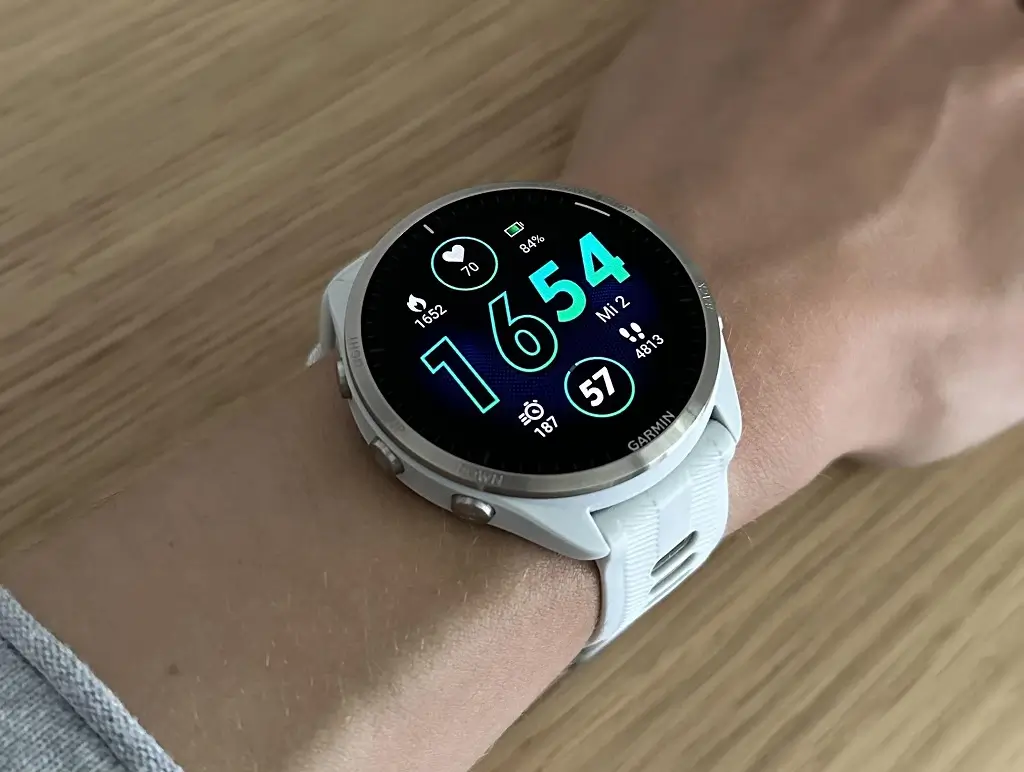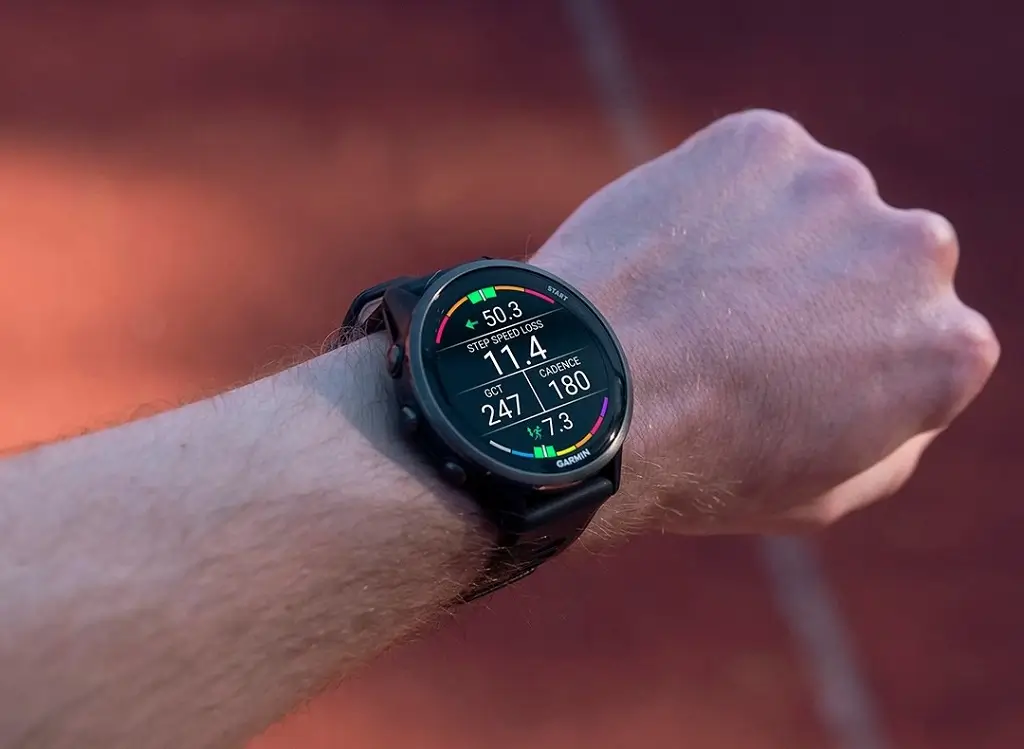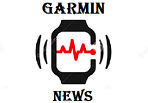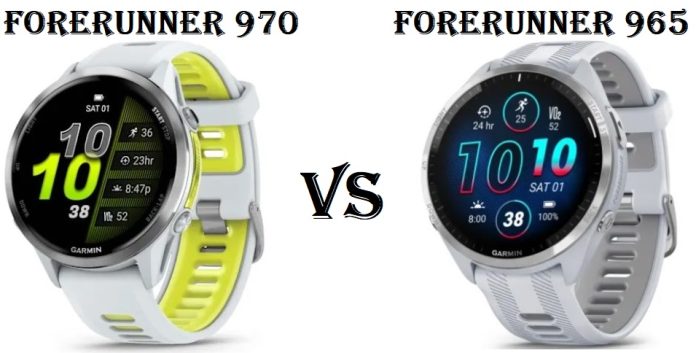Whispers and conjectures have finally materialized into reality – Garmin has officially launched its latest contender in the running watch arena, the Forerunner 970. While its initial silhouette bears a striking resemblance to the preceding 965 model, a deeper dive reveals a collection of practical augmentations. Among these new assets are an integrated illumination source, electrocardiogram functionality powered by the advanced Gen 5 heart rate sensor, the ability to track body temperature fluctuations, and the added resilience of a sapphire crystal protecting the display
Garmin Forerunner 970 VS 965: Specs Comparison
| Feature Category | Forerunner 965 | Forerunner 970 |
|---|---|---|
| Build & Design | ||
| Lens Material | Corning Gorilla Glass DX | Sapphire crystal |
| Physical Size | 47.1 x 47.1 x 13.2 mm | 47 x 47 x 12.9 mm |
| Weight | 53 g | 56 g |
| Health & Wellness | ||
| Heart Rate Sensor | Elevate V4 | Elevate V5 |
| Skin Temperature | No | Yes |
| ECG | No | Yes |
| Smart Features | ||
| Built-in Speaker/Microphone | No | Yes |
| Evening Report | No | Yes |
| Bluetooth Calling & Voice Assistant | No | Yes |
| Voice Command | No | Yes |
| Training & Performance | ||
| Garmin Triathlon Coach | No | Yes |
| Step Speed Loss | No | Yes (with compatible accessory) |
| Running Tolerance | No | Yes |
| Running Economy | No | Yes (with compatible accessory) |
| Projected Race Time & Pace | No | Yes |
| Gym & Activity Profiles | ||
| Gym Profiles | Standard list | Adds Jump Roping |
| Multisport Profiles | Triathlon, Swimming/Running | Adds Duathlon, Brick, Pool Triathlon |
| Wellness Profiles | Walking, Pilates, Yoga | Adds Indoor Walking, Mobility |
| Outdoor Running Profiles | Running, Outdoor Track, Trail, Ultra | Adds Obstacle Racing |
| Outdoor Recreation Profiles | Hiking, Mountaineering, Indoor Climbing, Bouldering, Golf, Disc Golf | Adds Hunting, Horseback Riding, Archery |
| Cycling Profiles | Same core list | Adds BMX |
| Water Sports Profiles | Stand Up Paddleboarding, Rowing | Adds Kayaking, Fishing, Boating, Sailing, Sail Racing, Snorkeling, Sailing Expedition |
| Snow & Winter Profiles | XC Classic Skiing only | Adds XC Skate Skiing |
| Battery Life | ||
| Smartwatch Mode | Up to 23 days | Up to 15 days |
| GPS-Only GNSS Mode | Up to 31 hours | Up to 26 hours |
| SatIQ (AutoSelect) GNSS Mode | Up to 22 hours | Up to 23 hours |
| All-Systems GNSS + Multi-Band | Up to 19 hours | Up to 21 hours |
| GPS-Only GNSS with Music | Up to 10.5 hours | Up to 14 hours |
| SatIQ (AutoSelect) GNSS with Music | Up to 9 hours | Up to 13 hours |
| All-Systems GNSS + Multi-Band with Music | Up to 8.5 hours | Up to 12 hours |
| Price | $600 | $750 |
Design and Build: Subtle Refinements

From a visual standpoint, the Forerunner 970 maintains a familiar aesthetic, sharing the same case dimensions and display size as its predecessor. However, Garmin has subtly reduced the thickness and slightly increased the weight. A significant upgrade lies in the display material, with the 970 adopting a sapphire crystal lens, a departure from the Gorilla Glass DX found on the 965.
This aligns it with Garmin’s premium offerings while retaining the 1.4-inch AMOLED display. Contrary to speculation, the 970 features an AMOLED screen, indicating that a potential MIP display model, perhaps a “975,” is not part of this release. Both the 970 and 965 are compatible with 22mm QuickFit bands and accommodate similar wrist sizes. Although the weight difference is marginal, it might be perceptible during extended activities.
Enhanced Health and Wellness Tracking

The most significant internal change is the integration of the Elevate V5 sensor, an upgrade from the Elevate V4. This new sensor unlocks several key health-focused features. The Forerunner 970 now offers electrocardiogram (ECG) readings and incorporates skin temperature tracking, both absent in the 965. These additions position the 970 as a more comprehensive health and wellness tracker.
Furthermore, the introduction of the “evening report” provides users with a consolidated overview of their recovery and readiness, taking into account sleep patterns, training load, and heart rate variability (HRV) trends. This emphasizes Garmin’s aim to provide richer context around performance, moving beyond simple data collection.
Advanced Metrics for Dedicated Runners
Serious runners will appreciate the suite of new analytical tools available on the Forerunner 970. Features like step speed loss, running tolerance, projected race time, and running economy (when paired with the HRM 600) are now supported. While some of these metrics require external accessories, they are designed to help athletes monitor fatigue levels and track their performance potential over time.
Expanded Sport Profiles for Diverse Activities
The Forerunner 970 boasts an extensive list of new sport profiles. For indoor workouts, jump roping has been added. Multisport enthusiasts gain support for duathlon, brick workouts, and pool triathlon. Wellness tracking expands with the inclusion of mobility and indoor walking, complementing the existing yoga and Pilates modes. Outdoor runners benefit from a dedicated obstacle racing profile.
Notably, water and snow sports see the most significant additions, with profiles for kayaking, snorkeling, sailing, fishing, and various winter activities such as XC skate skiing. Outdoor recreation now includes archery, horseback riding, and hunting, while BMX joins the cycling options.
Smart Features: Microphone, Speaker, and Flashlight
A key differentiator from the Forerunner 965 is the inclusion of a built-in microphone and speaker in the 970. This enables Bluetooth calling directly from the wrist, as well as support for voice assistants and direct voice commands to the watch. These features bridge the gap between the Forerunner series and Garmin’s Venu lineup in terms of everyday smart utility, without compromising its focus on athletic performance. Additionally, the Forerunner 970 incorporates an integrated LED flashlight, a practical feature previously seen in Garmin’s premium Fenix series.
Battery Life: A Trade-Off
Battery performance presents a mixed picture. In smartwatch mode, the Forerunner 965 offers longer battery life, lasting up to 23 days compared to the 970’s 15 days. However, for users who frequently utilize GPS with music, the 970 takes the lead, particularly in the more accurate multi-band mode. This battery trade-off suggests that the optimal choice may depend on individual usage patterns, specifically the reliance on offline music or streaming during activities.
Conclusion: An Evolution, Not a Revolution
The Garmin Forerunner 970 is not a complete overhaul of the 965. However, for users who have been waiting for enhanced build quality with a Sapphire display, more in-depth training metrics, and broader sport profile coverage, the Forerunner 970 offers compelling upgrades that may justify the step up. The watch will be available starting May 21st at $750, approximately $150 more than the launch price of the Forerunner 965.
BUY Garmin Forerunner 970 At Amazon
BUY Garmin Forerunner 965 At Amazon
Also Read: Garmin officially confirms new features will be hidden behind a paywall

